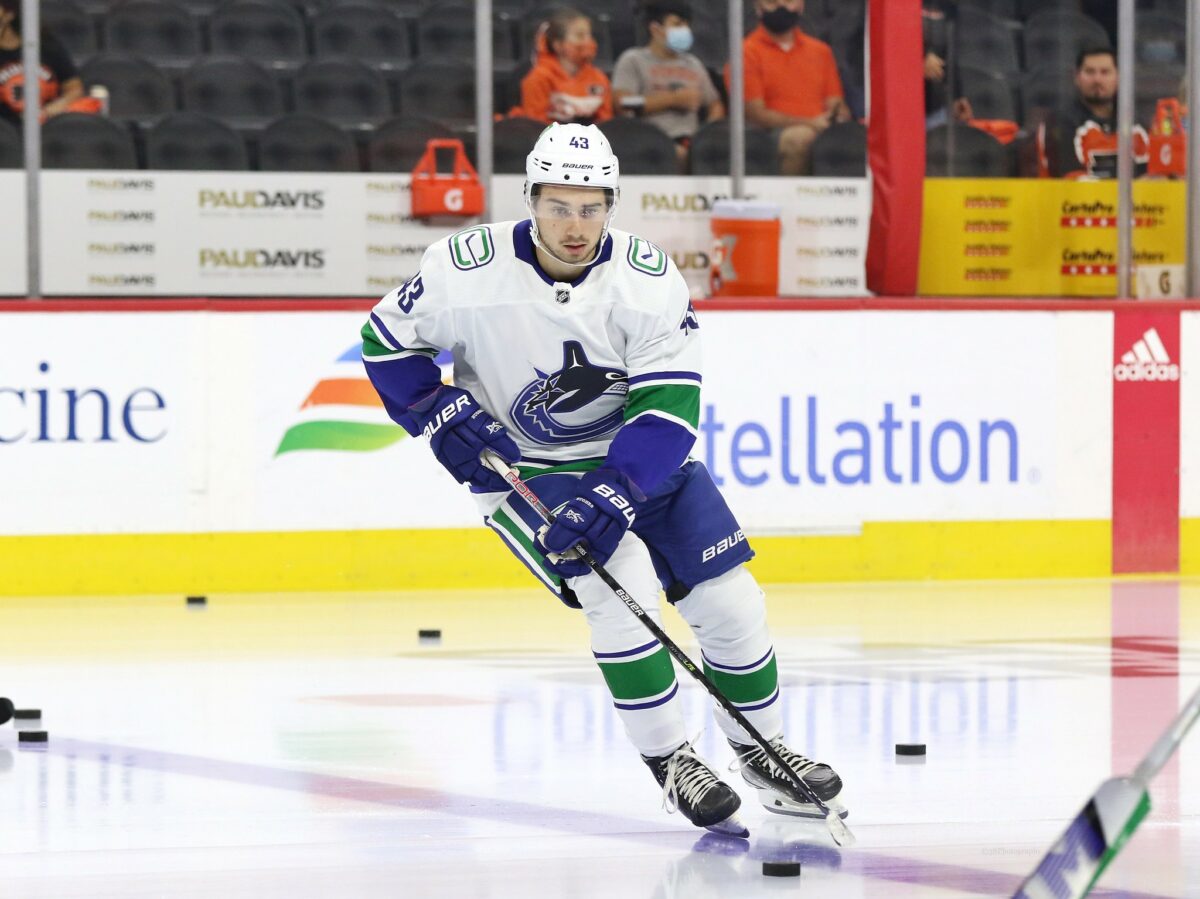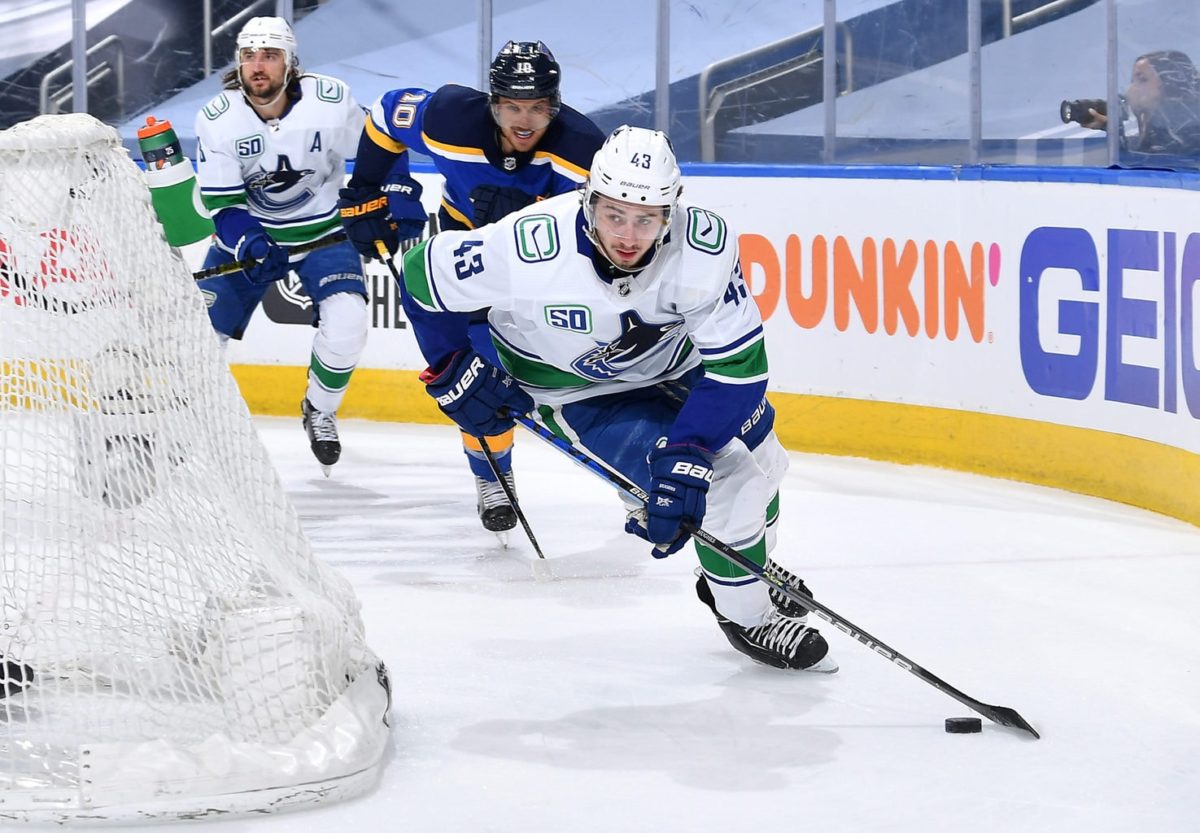Young, puck moving offensive defenceman are all the rage in today’s NHL. Players like Cale Makar, Miro Heiskanen and Adam Fox are just a few examples of what every team is looking for in a young, cornerstone d-man. There are so many young players getting recognition early in their careers, yet somehow in his third season in the league, Quinn Hughes is still overlooked among the young defenseman in the league today.
There was definitely hype when Hughes burst onto the scene in Vancouver. From being a top-two Calder Trophy nominee, to being in the top-15 in Norris Trophy voting his first season. But it has evaporated quickly with the rise of some other defenders across the league. Not to mention, some veteran players that are still at the top off the league including Victor Hedman, Roman Josi, Kris Letang and John Carlson just top name a few. But with Hughes, there isn’t a part of his game that hasn’t grown since entering the league in 2018. His offensive totals have been there since day one, his defensive game has come a long way, and he is becoming an integral leader and a major part of the core for the Canucks.
Offensive Totals So Far
If there is a way to get hyped yp around the NHL as a defenceman, it’s on the offensive side of the puck. Hughes’ offensive totals so far in his career have been right on the elite level with some of the players who are seemly being talked about daily. While they deserve to be, Hughes needs to be a part off that group and daily conversation as well, and when compared to some of his younger counterparts, he’s right there.

Through his first three seasons in the league, Hughes has compiled 122 points through 159 games, averaging .77 points-per game (PPG). While Makar is definitely playing on another level with 129 points through his first 101 games (1.28 PPG), Hughes is on par with some of the best in the game. To put it in perspective of some of the other top defensemen around the league, the reining Norris Trophy winner Fox, has put up 126 points in 163 games in his career, which accumulates to .77 PPG. Identical to Hughes. Victor Hedman, who is arguably the best defender in the game today, has 139 points over his last three seasons (159 games), which equals out to .87 PPG. Those numbers are not that far off, though many would argue Hedman’s defensive game is far superior to Hughes’. Having said that, his defensive game has come a long way.
Defensive Game Has Come A Long Way
The one part of the game that has been scrutinized since Hughes arrived in the league has been in the defensive zone. It’s difficult enough coming into the NHL as a teenager, let alone defend grown men and some of the best players in the world. While Hughes had some early struggles, his defensive game has come a long way since 2018.
Related: Canucks’ 5 Game Road Trip Will Be Their Biggest Test Under Boudreau
To compare from Hughes’ first season in 2019 the responsibility alone has significantly increased. In his first full season, Hughes averaged 21:53 time on-ice per game (TOI). Fast forward to this season, and Hughes is bordering on nearly 25 minutes a night, averaging 24:44 TOI per game. That put his above Makar (24:28 TOI) and Fox (24:40 TOI). Hughes’ even-strength minutes have also gone up two minutes per-game, from 18:01 TOI to 20:49 TOI, nearly three minutes more per game.
The other stat that has greatly improved is his Corsi For percentage in all situations (CF%). By definition, “Being above 50% means the team was controlling the puck more often than not with this player on the ice in all situations”. It’s the analytical darling stat that every hockey organization and scouting report uses, and Hughes has only improved in that area. He’s never been below 56 CF%, but this year has been even better, with a 61.3 CF%. His Corsi For Per 60 minutes CF/60 has been even better, at a 68.3 % rating, which accounts for shots, blocks and misses per 60 minutes. It’s safe to say that the Canucks are a better team, both offensively and defensively, with Hughes on the ice.
Becoming a Leader and Core Member
The game today is starting to see younger players take on leadership roles very early in their careers. Going back to when players like Sidney Crosby and Alex Ovechkin were named captains of their respective teams before the age of 25, it’s becoming more and more common. Even if players aren’t named captains, guys like Auston Matthews and Nathan Mackinnon have taken off major leadership roles, despite not wearing the captains letter on their chest. Despite Hughes not even wearing a letter, it’s quite obvious he’s becoming a leader and core member of this Canucks team.

When Hughes was signed in the offseason to a six year contract, with an average annual value (AAV) of $7.85 million, it was a showing of a long term commitment to a young player who is locked up for most of his 20’s. Not to mention, his cap hit compared to some of the other young defensemen signed over the offseason, he comes with the elite production at about $2 million less than the likes of Makar ($9 million), Narnell Nurse ($9.25 million), Seth Jones ($9.5 million), and Zach Werenski ($9.58 million).
You may also like:
- NHL Rumors: Red Wings, Oilers, Maple Leafs, Canucks
- Pettersson & Miller Try to Shut Down Rumours of a Rift in the Canucks Locker Room
- Vancouver Canucks Prospects Playing at the 2025 World Junior Championship
- Elias Pettersson Leads Canucks to 4-3 Win Over Sharks
- Projected Lineups for the Sharks vs Canucks – 12/23/24
From taking accountability, improving defensively and putting up elite offensive numbers, the narrative has weirdly been that Hughes has been overlooked throughout his career, but after looking at all the numbers, and his improvement from 2019, to now 2022 (to go along with an NHL All-Star snub this season), the case could be made that it is in fact the opposite, and Hughes should be talked about a lot more.